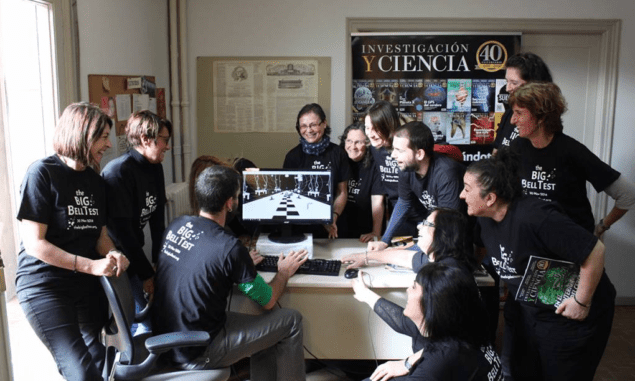
The Big Bell Test Collaboration has put quantum entanglement to the test with help from about 100,000 computer gamers worldwide. Run by an international team of physicists, the experiment used decisions by members of the public to close the “freedom of choice loophole” in several different Bell tests – which show that the quantum entanglement of two systems violates local realism.
The idea of quantum entanglement dates to 1935, when Albert Einstein, Boris Podolsky and Nathan Rosen pointed out that two quantum particles can be in a state in which a measurement on one particle instantaneously affects the other – no matter how far apart they may be. This entanglement of particles cannot happen in the world of classical physics because it would require information to travel faster than the speed of light.
Stronger correlations
Since then physicists have shown that entanglement can be determined by looking at correlations between measurements made on the two particles. Entangled particles have much stronger correlations than are allowed in classical physics – a property that can be exploited in quantum computers and other quantum technologies.
In 1964 the Northern Irish physicist John Bell famously calculated an upper limit on how strong these correlations could be if they were caused by classical physics alone – what has become known as Bell’s inequality. Stronger correlations could only occur only if the particles were entangled – and confirming entanglement in this way has since been dubbed a Bell test.
Experiments using photons, ions and other entangled particles have confirmed that Bell’s inequality is indeed violated. However, these experiments are plagued by one or more loopholes that could allow unforeseen effects of classical physics to cause the violation.
Measurement choices
Bell tests usually involve producing large numbers of entangled pairs and making random measurements on certain properties of particles in each pair. For example, either the horizontal or vertical polarization of a photon can be measured. There cannot be any inherent correlations in how these measurements are chosen – and the inability to completely rule out the existence of such correlations in an experiment is called the freedom of choice loophole.

John Bell and the most profound discovery of science
It turns out that this loophole can be closed if the measurement choices are made by humans, rather than by random number generators. This was done by inviting people to play a video game called The Big Bell Quest, which involved players randomly pressing their “0” and “1” keys. On 30 November, 2016 more than 97 million bits were fed to 13 different Bell test experiments worldwide. These tests used a variety of entangled particles and systems including photons, atoms and superconducting devices.
As well as closing the freedom of choice loophole, the collaboration also showed that random numbers can be collected rapidly from large numbers of people. New networking techniques were also developed to allow worldwide participation in laboratory experiments.
The Bell tests are described in Nature.



